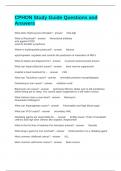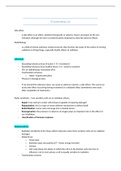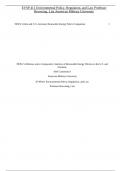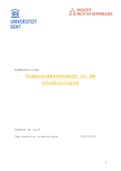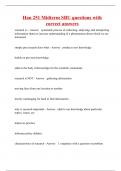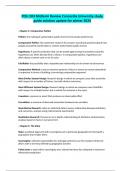Geographies of developing areas:
Williams, G, etc.
Chapter 1 ~ Introduction.
This is a textbook about the ‘global south’.
Brandt line: dividing line between rich and powerful north and poor and
marginalized south. (was the idea, in fact on both sides there are poor and rich
countries). This division still shapes the way the south is imagined, talked about
and studied → the south is under-represented in research and students in the
north only learn about the problems. This reinforces negative stereotypes and
represents the south as a collection of places and people in need of external
intervention. It also differs these areas as a ‘specialism’ for research away from
the mainstream sciences.
In this book they use the brandt line but highlight the diversity that exists south of that line
rather than present a singular view. What does link the regions of our definition, however, is
that these are the parts of the world that have been commonly described for many decades
now as developing areas.
Space: ‘a container in which things happen’, but also mentally constructed as mind maps
e.g., Nowadays often seen as ‘produced through social interactions within material space’
(e.g. kitchen is a space but often feminine in a house, while masculine in a restaurant).
Place: ‘a meaningful site that combines location, locale and sense of place’. Nowadays
places more seen as open instead of having clear boundaries, they are continually reworked
through the interactions of economic, social and political processes in particular locations.
The agenda of rethinking the study of ‘developing areas’ has 4 main arguments:
● representations of the global south matter (what results does these have for them?).
○ effects can be badly informed audiences.
○ also helps decision making over aid and international policy (‘the right’ to
intervene because necessary).
○ people see them as being behind on the north or lacking things while just
being different.
○ Here used is the power of representation.
● North and south intimately linked through a range of global processes (what does
globalization mean for them?).
○ growing sense of ‘global community’.
○ global terror networks
○ does not mean that differences in culture and identity are disappearing. The
Global South is not just made up by a set of ‘traditional’ cultural practices that
are about to be steamrollered out of existence by a ‘global’ culture.
○ reshaping globalization’s effects is something that everybody can, to some
degree, participate in through their own actions.
● understanding the south requires detailed engagement and agency.
○ Places in the south are actively involved in producing global systems.
○ need for geographical knowledge of places and cultures.
○ ‘mainstream’ social science often has some culturally specific assumptions
written into it.
, ○ A thorough engagement with the Global South should not only improve
understanding of ‘distant’ places, but also encourage challenges to theoretical
models based around the experiences of the North (through the
understanding of the differences).
● providing an introduction to the Global South is not the same as telling the story of
international development (there is much more than only developing!).
○ The aims of development are as varied as human imaginations of a better
world can be and these different driving ambitions have their own limitations
and contradictions.
○ the content of development theory and practice is equally varied.
○ here: focus on 3 inspirations for change: wealth creation, rational planning
and popular participation.
○ “development” a contested concept.
Power: * ability to command or control the actions of others/power over others (male in
household or government over citizens), *ability to control and deploy resources/ power to
achieve desired ends (such as multinational companies) * power within the operation of
everyday techniques, strategies and practices/ power of representation (such as strict
timetables or performance criteria).
Chapter 2 ~ Imagining the south.
representation: The ways in which language, symbols, signs and images stand for objects,
people, events, processes or things. Two processes:
● principles of organization through which objects, people, etc. are conceptualized and
represented in our minds.
● language as the second system of representation. ‘Language’ does not refer purely
to written or spoken words, but also to images, signs, symbols and noises for
example. We need this to share 1.
Meaning is not inherent to the object but constructed in social contexts. the meanings
associated with particular objects, people or practices and the language used to
communicate about them will reflect and reinforce forms of power.
Discourse: not only conversation or speech but also what is meaningful and how particular
topics should be approached. The exercise of power is clearly relevant in shaping discourse
as not everyone or all groups will have the same agency.
Postcolonialism: A theoretical approach that reveals the operation of power in the
construction of definitions and understandings of peoples and places affected by colonialism
and its aftermath. mostly used to discuss a time period after independence.
Eurocentrism: the belief that the European experience is the norm against which non-
European experiences are evaluated. Europe as the ‘core’ and norm for progress and
modernity.
The south as seen from the north.
There are four common types of northern representation of the south:
1. Exotism and eroticism. European visions on the world have been based on ‘othering’.
The middle east was, for example, exotic, mysterious and static compared to the
west (orientalism). Described was what Europeans perceived as societies lacking
civilization, particularly due to types of clothing, housing and the absence of Christian
Williams, G, etc.
Chapter 1 ~ Introduction.
This is a textbook about the ‘global south’.
Brandt line: dividing line between rich and powerful north and poor and
marginalized south. (was the idea, in fact on both sides there are poor and rich
countries). This division still shapes the way the south is imagined, talked about
and studied → the south is under-represented in research and students in the
north only learn about the problems. This reinforces negative stereotypes and
represents the south as a collection of places and people in need of external
intervention. It also differs these areas as a ‘specialism’ for research away from
the mainstream sciences.
In this book they use the brandt line but highlight the diversity that exists south of that line
rather than present a singular view. What does link the regions of our definition, however, is
that these are the parts of the world that have been commonly described for many decades
now as developing areas.
Space: ‘a container in which things happen’, but also mentally constructed as mind maps
e.g., Nowadays often seen as ‘produced through social interactions within material space’
(e.g. kitchen is a space but often feminine in a house, while masculine in a restaurant).
Place: ‘a meaningful site that combines location, locale and sense of place’. Nowadays
places more seen as open instead of having clear boundaries, they are continually reworked
through the interactions of economic, social and political processes in particular locations.
The agenda of rethinking the study of ‘developing areas’ has 4 main arguments:
● representations of the global south matter (what results does these have for them?).
○ effects can be badly informed audiences.
○ also helps decision making over aid and international policy (‘the right’ to
intervene because necessary).
○ people see them as being behind on the north or lacking things while just
being different.
○ Here used is the power of representation.
● North and south intimately linked through a range of global processes (what does
globalization mean for them?).
○ growing sense of ‘global community’.
○ global terror networks
○ does not mean that differences in culture and identity are disappearing. The
Global South is not just made up by a set of ‘traditional’ cultural practices that
are about to be steamrollered out of existence by a ‘global’ culture.
○ reshaping globalization’s effects is something that everybody can, to some
degree, participate in through their own actions.
● understanding the south requires detailed engagement and agency.
○ Places in the south are actively involved in producing global systems.
○ need for geographical knowledge of places and cultures.
○ ‘mainstream’ social science often has some culturally specific assumptions
written into it.
, ○ A thorough engagement with the Global South should not only improve
understanding of ‘distant’ places, but also encourage challenges to theoretical
models based around the experiences of the North (through the
understanding of the differences).
● providing an introduction to the Global South is not the same as telling the story of
international development (there is much more than only developing!).
○ The aims of development are as varied as human imaginations of a better
world can be and these different driving ambitions have their own limitations
and contradictions.
○ the content of development theory and practice is equally varied.
○ here: focus on 3 inspirations for change: wealth creation, rational planning
and popular participation.
○ “development” a contested concept.
Power: * ability to command or control the actions of others/power over others (male in
household or government over citizens), *ability to control and deploy resources/ power to
achieve desired ends (such as multinational companies) * power within the operation of
everyday techniques, strategies and practices/ power of representation (such as strict
timetables or performance criteria).
Chapter 2 ~ Imagining the south.
representation: The ways in which language, symbols, signs and images stand for objects,
people, events, processes or things. Two processes:
● principles of organization through which objects, people, etc. are conceptualized and
represented in our minds.
● language as the second system of representation. ‘Language’ does not refer purely
to written or spoken words, but also to images, signs, symbols and noises for
example. We need this to share 1.
Meaning is not inherent to the object but constructed in social contexts. the meanings
associated with particular objects, people or practices and the language used to
communicate about them will reflect and reinforce forms of power.
Discourse: not only conversation or speech but also what is meaningful and how particular
topics should be approached. The exercise of power is clearly relevant in shaping discourse
as not everyone or all groups will have the same agency.
Postcolonialism: A theoretical approach that reveals the operation of power in the
construction of definitions and understandings of peoples and places affected by colonialism
and its aftermath. mostly used to discuss a time period after independence.
Eurocentrism: the belief that the European experience is the norm against which non-
European experiences are evaluated. Europe as the ‘core’ and norm for progress and
modernity.
The south as seen from the north.
There are four common types of northern representation of the south:
1. Exotism and eroticism. European visions on the world have been based on ‘othering’.
The middle east was, for example, exotic, mysterious and static compared to the
west (orientalism). Described was what Europeans perceived as societies lacking
civilization, particularly due to types of clothing, housing and the absence of Christian




